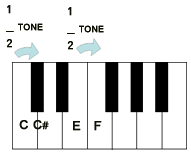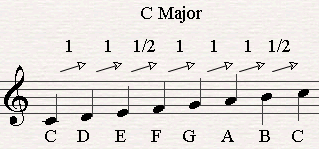The Music Scale - Major Scales on Piano Starting with the C Major Scale.
Home » Piano Theory » The Music Scale
What's a musical scale?
A musical scale is a selection of certain notes within an octave.

So, you're curious to learn about forming scales... In this section
I'll explain all about scales and more important what you could do with it.
Why Bother Studying Musical Scales?
1. First of all you need to know that popular music and most of the "Classical music" are both built out of scales. That means that when you start to study a new piece you you'd be able to find you way more quickly if you recognize its scale. You'll be familiar with the nature of the piece.
2.Chords are made out of scales too. Every chord holds a hint to the scale from which it comes from. Knowing the scale will help us a great deal to know how the chord unction in the music we're playing.
in the Piano Chords Theory Page you'll learn how to recognize the chords that belong to each and every major scale and later on we'll learn to play chords by ear.
3. Playing piano by ear - Knowing the scales along with a good musical intuition is the code to play melodies by ear.
4. Improvising - Scales are great improvising tools. We can use them to improvise in a challenging manner. I'll talk about this later...
5. Exercising - Scales are great for practicing your technique and concentration.
Click here to learn how to play the various piano scales in practice.

Just a reminder... A half step or a half tone is the distance from one key on
the keyboard to the next adjacent key. It doesn't matter whether it's a black key or a white key.
A whole step is the distance as two half steps.
That's how we can measure the music scales.
Question:
What is the distance between B and C? B and C#?
The Major Music Scale
The major music scale is a very common scale and is often interpreted in music as an optimistic or a happy scale.
Let's take for example the C major scale which is built of these notes : C-D-E-F-G-A-B-C.
This music scale is made out of eight notes which happen to be all white.
C is its root tone.
The distance between C and D is one step/tone(C-C#-D).
The distance between D and E is one step/tone too.
If we keep measuring this is what we get...

As a matter of fact we can now say that the major scale is built out of this formula.
W W h, W W W h
W's represtent a whole step and h's represent a half step.
All major scales have the same order of steps and half steps so we can use this formula to build all twelve major scales. All we have to do is start on the first note and follow the formula.
Question:
If so can you try to find G major on the piano?
Try to find D major as well. Start on the the first note and follow the formula.
Click here to see if you got it right and to continue in our piano scales lessons.
Music Modes
The Ionian Mode
The Dorian Mode
The Phrygian Mode
The Lydian Mode
The Mixolydian Mode
The Aeolian Mode
The Locrian Mode
Return from The Music Scale to Piano Theory














